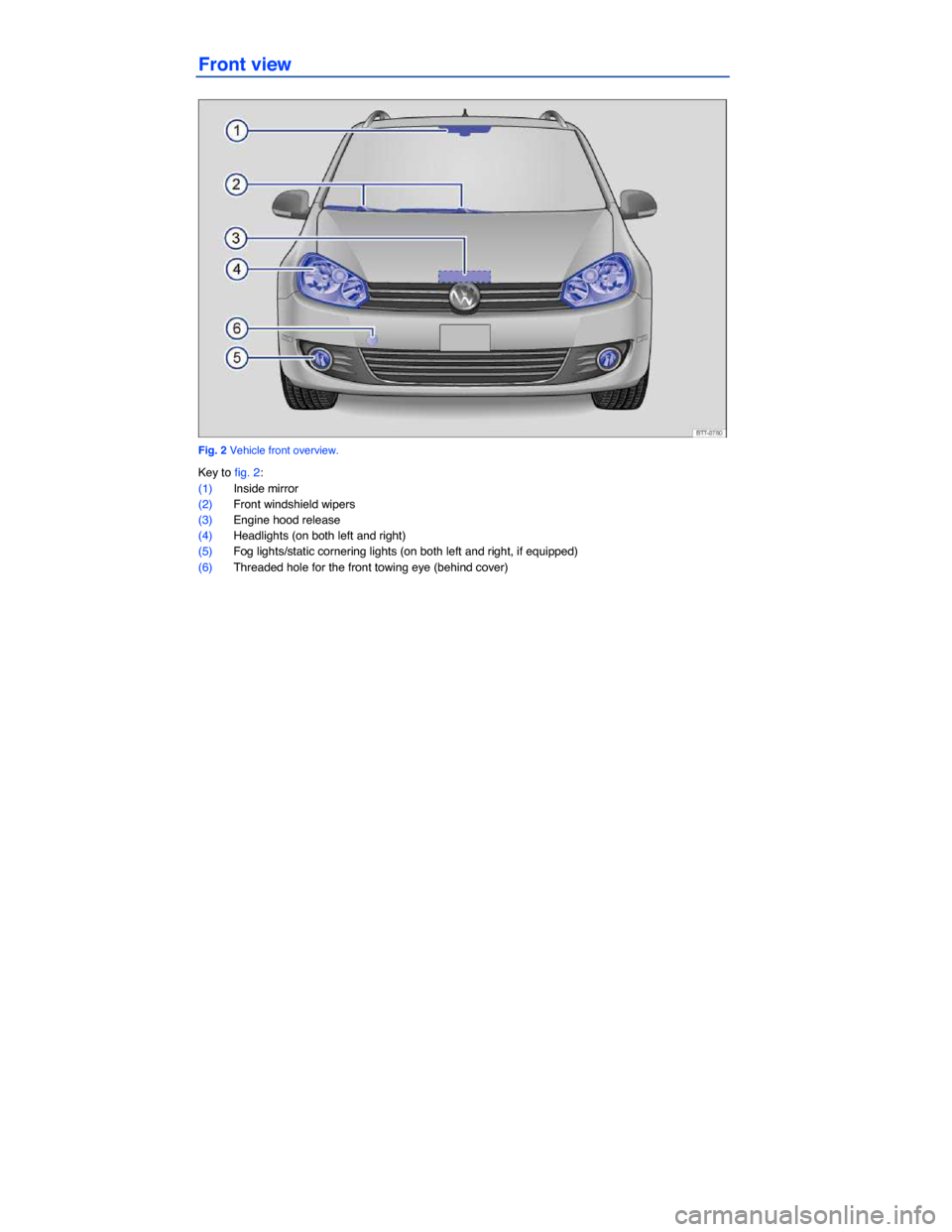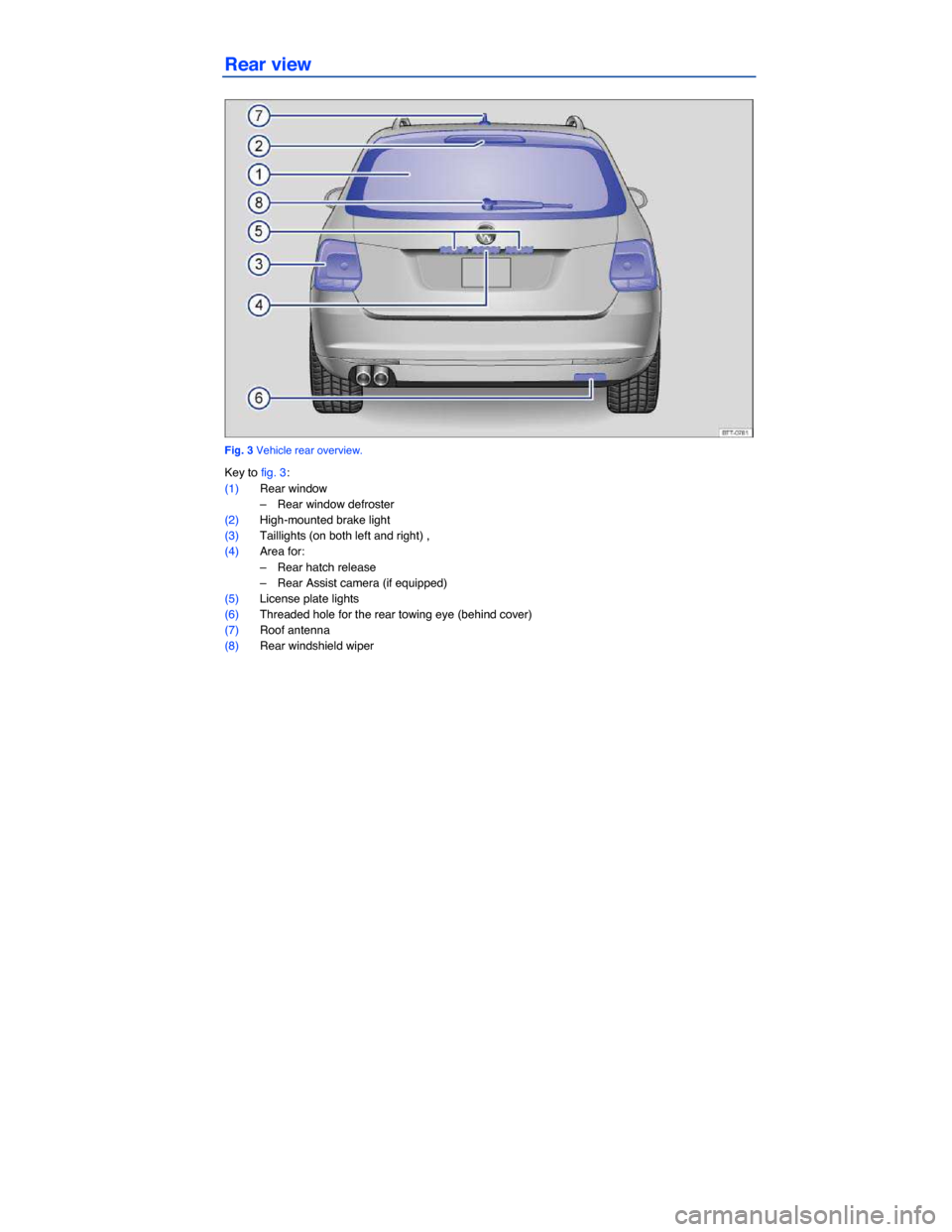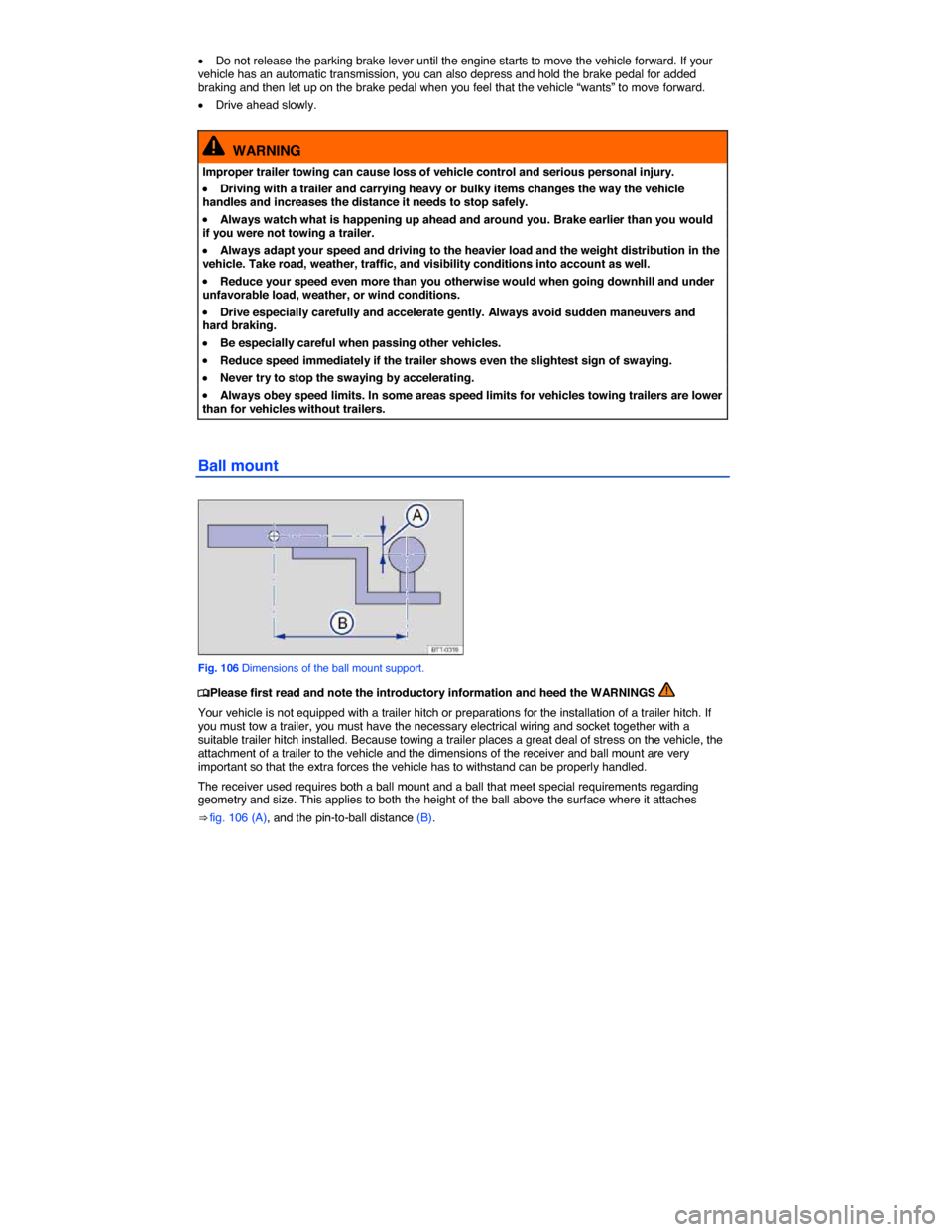2014 VOLKSWAGEN JETTA SPORTWAGEN towing
[x] Cancel search: towingPage 2 of 373

Front view
Fig. 2 Vehicle front overview.
Key to fig. 2:
(1) Inside mirror
(2) Front windshield wipers
(3) Engine hood release
(4) Headlights (on both left and right)
(5) Fog lights/static cornering lights (on both left and right, if equipped)
(6) Threaded hole for the front towing eye (behind cover)
Page 3 of 373

Rear view
Fig. 3 Vehicle rear overview.
Key to fig. 3:
(1) Rear window
– Rear window defroster
(2) High-mounted brake light
(3) Taillights (on both left and right) ,
(4) Area for:
– Rear hatch release
– Rear Assist camera (if equipped)
(5) License plate lights
(6) Threaded hole for the rear towing eye (behind cover)
(7) Roof antenna
(8) Rear windshield wiper
Page 28 of 373

¥ Assume a proper seating position before the vehicle starts to move and keep this position while driving. Make sure that all passengers do the same, Adjusting the seating position.
¥ Properly fasten your safety belt before driving the vehicle and wear your safety belt properly at all times while driving. Make sure that all passengers do the same, Safety belts.
¥ Only transport as many passengers as there are seats and safety belts available.
¥ Never drive if your driving ability has been impaired, for example by medication, alcohol or illegal drugs.
¥ Never let passengers or phone calls distract you while driving, and never take your attention off the road while using vehicle software or adjusting vehicle equipment or accessories.
¥ Always adapt your speed and driving style to visibility, weather, road, and traffic conditions.
¥ Always obey traffic laws and speed limits.
¥ On long trips make frequent rest stops – at least once every 2 hours.
¥ Secure animals in the vehicle with a system that corresponds to weight and size.
WARNING
Always observe traffic rules and posted speed limits and use common sense. Your good judgment can mean the difference between arriving safely at your destination and being seri-ously injured in a crash or other kind of accident.
Regular service and maintenance of your vehicle is important both for operational and driving safety and to help prolong your vehicle's service life. Always follow the scheduled maintenance inter-
vals in the ⇒ booklet Warranty and Maintenance, especially for changing the brake fluid. Hard use, frequent stop-and-go driving, driving in very dusty areas, trailer towing, and other factors may make it necessary to have the vehicle serviced more frequently. Ask an authorized Volkswagen dealer or an authorized Volkswagen Service Facility for more information.
Driving in other countries
�
Page 115 of 373

WARNING
Unsecured or incorrectly stowed items can fly through the vehicle, causing serious personal injury during hard braking or sharp steering or in an accident. Loose items can also be struck and thrown through the passenger compartment by the front airbags if they inflate. To help reduce the risk of serious personal injury:
�x Always stow all objects securely in the vehicle.
�x Always keep storage compartments closed while driving.
�x Do not stow hard, heavy, or sharp objects in open bins in the vehicle or on top of the instrument panel.
�x Remove hard, heavy, and sharp objects from clothing and bags in the vehicle interior and stow securely. Always put heavy items in the luggage compartment.
�x Always secure objects in the passenger compartment properly with suitable straps so that they cannot move into the deployment area of a side or front airbag during braking, in a sudden maneuver, or in a collision.
�x Always make sure that there is nothing on the front passenger seat when the backrest is folded forward. When the backrest is folded forward, even light objects could be pushed into the seat cushion and cause the weight-sensing mat in the seat to register enough weight to turn the airbag on, How to tell if the front passenger front airbag is on or off.
�x Always make sure that the PASSENGER AIR BAG OFF 9 light is on and stays on whenever the backrest of the front passenger seat is folded forward, PASSENGER AIR BAG OFF 9 light.
�x Passengers must never ride in an incorrect seating position because objects are being transported in the vehicle.
�x Never let anybody sit in a seat that is blocked by objects being carried in the vehicle.
WARNING
Heavy loads will influence the way your vehicle handles and increase stopping distances. Heavy loads that are not properly stowed or secured can cause loss of control and serious injury.
�x Secure the load properly to keep it from shifting.
�x Always remember when transporting heavy objects that a change in the center of gravity also changes the way your vehicle handles:
– Always distribute the load as evenly as possible.
– Secure heavy objects properly as far forward in the luggage compartment as possible.
– Always tie down heavy items securely with suitable straps using the tie-downs in the luggage compartment.
�x Securely latch the rear seat backrest in the upright position.
�x Never exceed the Gross Axle Weight Rating or the Gross Vehicle Weight Rating on the safety compliance sticker on the left door jamb. Exceeding permissible weight can cause the vehicle to skid and handle differently.
�x Always adapt your speed and driving to the heavier load and the weight distribution in the vehicle. Take road, weather, traffic, and visibility conditions into account as well.
�x Always accelerate gently and avoid sudden braking and driving maneuvers.
�x Always brake earlier than you would if you were not driving a loaded vehicle.
Stowing luggage
�
Page 116 of 373

Always stow all luggage securely in the vehicle
�x Distribute the load in the vehicle, on the roof, and in the trailer as evenly as possible.
�x Put heavy objects as far forward as possible in the luggage compartment and securely latch the rear seat backrest in the upright position.
�x Secure luggage in the luggage compartment to the tie-downs with suitable straps, Luggage compartment.
�x Have the headlight range adjusted, if necessary, Lights.
�x Check the pressure in all 4 tires when the tires are still cold. Never reduce air pressure in warm tires to match cold tire inflation pressure. Heed the information on the tire pressure label, Tires and wheels.
�x Pay especially close attention to your vehicle's Tire Pressure Monitoring System when driving with a heavy load, Tire Pressure Monitoring System (TPMS).
NOTICE
The defroster heating wires or antenna in the rear window can be damaged by objects that rub against them.
Please review the information on loading a trailer, Trailer towing and a roof rack, Roof rack.
Driving with an open rear hatch
�
Page 134 of 373

Trailer towing
�
Page 135 of 373

WARNING
Improper use of the trailer hitch can cause accidents and injuries. An improperly installed, incorrect, or damaged trailer hitch can cause the trailer to separate from the towing vehicle and cause serious personal injuries.
�x Only use an undamaged, properly mounted trailer hitch.
�x Never repair or modify the trailer hitch.
�x To reduce the risk of injury in rear-end collisions, and the risk to pedestrians and cyclists when the vehicle is parked, always remove the ball mount when you are not towing a trailer.
�x Never install a “weight distributing” or “load equalizing” trailer hitch on your vehicle. The vehicle was not designed for these kinds of trailer hitches. The trailer hitch attachment can fail, causing the trailer to tear loose from the vehicle.
WARNING
Improper trailer towing can cause loss of vehicle control and serious personal injury.
�x Driving with a trailer and carrying heavy or large things can change the way the vehicle handles, increase the distance it needs to stop safely, and cause accidents.
�x Always secure the load properly with suitable and undamaged straps so that the load will not shift.
�x Always adapt your speed and driving to the heavier load and the weight distribution in the vehicle. Take road, weather, traffic, and visibility conditions into account as well.
�x Reduce your speed even more than you otherwise would when going downhill and under unfavorable load, weather, or wind conditions.
�x Trailers with a high center of gravity tip more easily than trailers with a low center of gravity.
�x Always avoid sudden maneuvers and hard braking.
�x Be especially careful when passing other vehicles.
�x Reduce speed immediately if the trailer shows the slightest sign of swaying.
�x Never try to stop the swaying by accelerating.
�x Always obey speed limits. In some areas, the speed limits for vehicles towing trailers are lower than for vehicles without trailers. Never drive faster than 50 mph (80 km/h; under exceptional circumstances 60 mph - 100 km/h), when towing a trailer. This applies even if the local speed limit is higher.
If you are driving a new vehicle or a vehicle with a new or rebuilt engine, do not tow a trailer during the break-in period, about 600 miles (1000 km), Parts, accessories, repairs, and modifications.
If you tow a trailer, your vehicle may need maintenance more often because of the extra load it has to move.
When you are not towing, remove the trailer hitch ball. This helps keep the trailer hitch from causing damage to your vehicle and to others if your vehicle is hit from behind.
Some models need a trailer hitch to tow or tow-start other vehicles. You may want to always carry the ball mount in the vehicle after it has been removed. Be sure to stow it securely.
Page 140 of 373

�x Do not release the parking brake lever until the engine starts to move the vehicle forward. If your vehicle has an automatic transmission, you can also depress and hold the brake pedal for added braking and then let up on the brake pedal when you feel that the vehicle “wants” to move forward.
�x Drive ahead slowly.
WARNING
Improper trailer towing can cause loss of vehicle control and serious personal injury.
�x Driving with a trailer and carrying heavy or bulky items changes the way the vehicle handles and increases the distance it needs to stop safely.
�x Always watch what is happening up ahead and around you. Brake earlier than you would if you were not towing a trailer.
�x Always adapt your speed and driving to the heavier load and the weight distribution in the vehicle. Take road, weather, traffic, and visibility conditions into account as well.
�x Reduce your speed even more than you otherwise would when going downhill and under unfavorable load, weather, or wind conditions.
�x Drive especially carefully and accelerate gently. Always avoid sudden maneuvers and hard braking.
�x Be especially careful when passing other vehicles.
�x Reduce speed immediately if the trailer shows even the slightest sign of swaying.
�x Never try to stop the swaying by accelerating.
�x Always obey speed limits. In some areas speed limits for vehicles towing trailers are lower than for vehicles without trailers.
Ball mount
Fig. 106 Dimensions of the ball mount support.
�